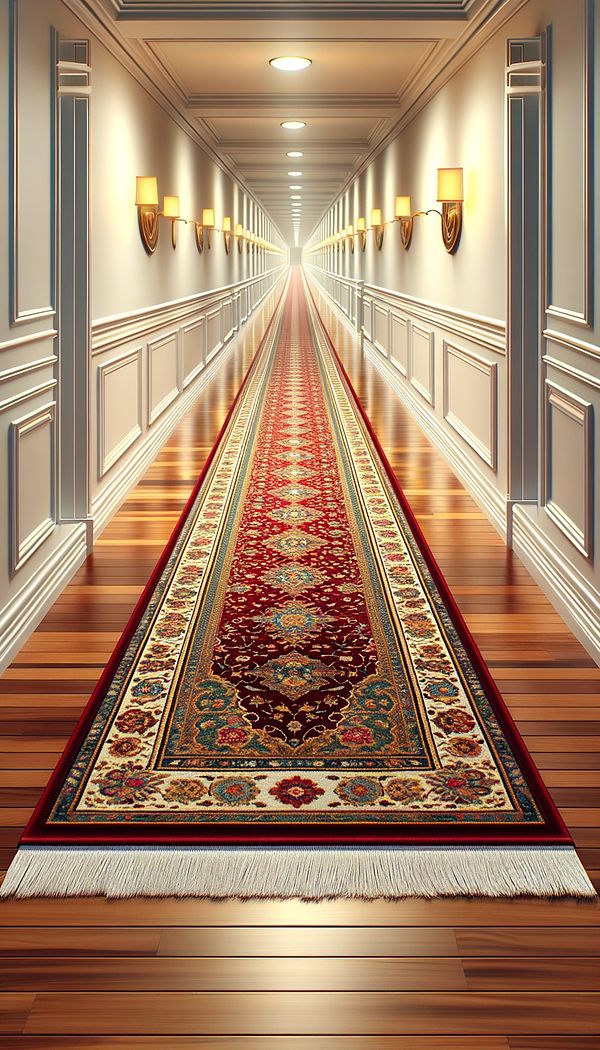What is a Runner?
A runner is a long, narrow rug designed to be placed in hallways or staircases.
Description
In the realm of interior design, a runner plays a significant role in both aesthetics and functionality. This elongated piece of carpeting is primarily used in hallways and on staircases, where standard rugs would not fit due to the unique dimensions of these spaces. Runners are not only practical in protecting the floors in high-traffic areas but also serve as a design element that can add warmth, color, and texture to a space. They are available in a variety of patterns, materials, and colors, allowing for customization according to the overall design scheme of a home or commercial space.
Runners can also be utilized in other long, narrow spaces such as galley kitchens and narrow foyers, providing a visual pathway and enhancing the sense of direction within the space. The choice of material for a runner can greatly impact its durability and maintenance requirements, with options ranging from synthetic fibers for high-traffic areas to luxurious wool or silk for a more upscale aesthetic.
Usage
A common application of a runner is in a residential hallway, where it can create a welcoming atmosphere while also protecting the flooring from wear. In commercial settings, runners are often used in hotel corridors or office hallways to add a touch of elegance and to help dampen sound. Runners are also popular on staircases, where they can provide additional grip and reduce noise from foot traffic.
FAQs
-
How do you choose the right size runner for a hallway or staircase?
The ideal size of a runner for a hallway or staircase depends on the dimensions of the space. Generally, it is recommended to leave an equal amount of floor space visible on both sides of the runner, ensuring it is neither too narrow nor too wide for the area. For staircases, the runner should cover the majority of each step while leaving some of the underlying stair visible on the sides.
-
Can runners be used outdoors?
Yes, runners can be used outdoors, especially in covered areas such as porches or patios. It is important to select a runner made from durable, weather-resistant materials such as polypropylene or natural fibers that are treated for outdoor use.
-
How do you clean and maintain a runner?
The cleaning and maintenance of a runner depend on its material. Vacuuming on a regular basis helps to remove dirt and debris, and spot cleaning with a mild detergent can address stains. Some runners, particularly those made from synthetic fibers, can be machine washed, while others, like wool or silk, may require professional cleaning.
Practical Application
When selecting a runner for your interior space, consider not only its aesthetic appeal but also its functionality and durability. For high-traffic areas, choose materials that are easy to clean and can withstand wear. Experiment with color and pattern to enhance the visual interest of your space, and make sure to measure your area accurately to select the right size runner. Additionally, using a non-slip pad underneath a runner can help to prevent it from sliding, ensuring safety in the space.
-
Decorative Techniques322 articles
-
Decorating Principles & Elements330 articles
-
Materials & Textiles360 articles
-
Flooring & Carpets48 articles
-
CenterpieceA centerpiece is an item or group of items placed at the center of a table or surface to serve as the focal point of a setting.
-
CaroleanCarolean refers to the style of furniture and interior design from the reign of Charles II in England.
-
HyggeHygge is a Danish and Norwegian word for a mood of coziness and comfortable conviviality with feelings of wellness and contentment.
-
Lay OffLay off is the process of applying a final, very thin coat of paint or varnish in a specific manner to ensure a smooth finish.
-
Persian RugA Persian rug is a handwoven carpet from Iran, known for its intricate designs and high quality.
